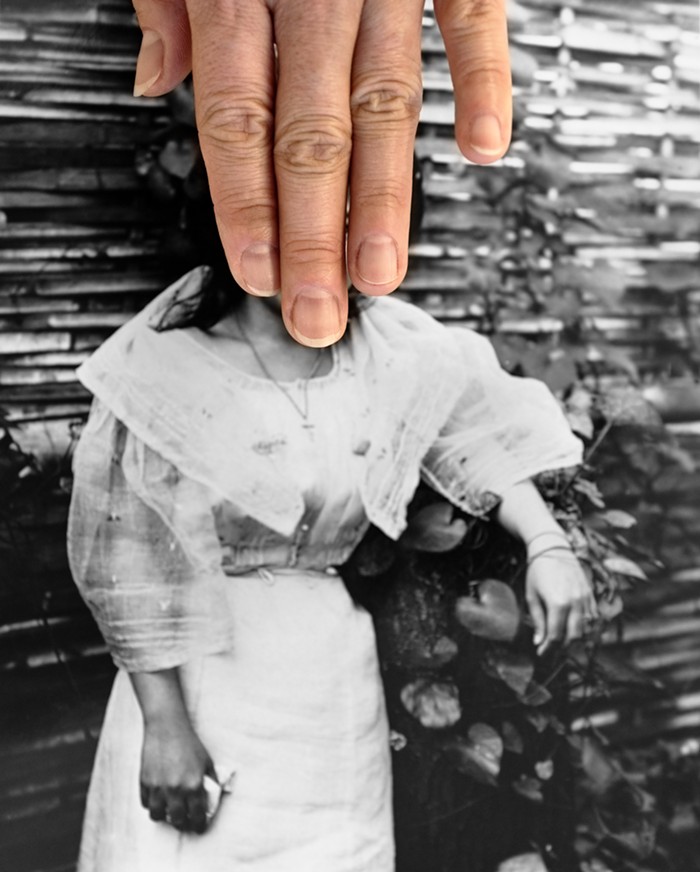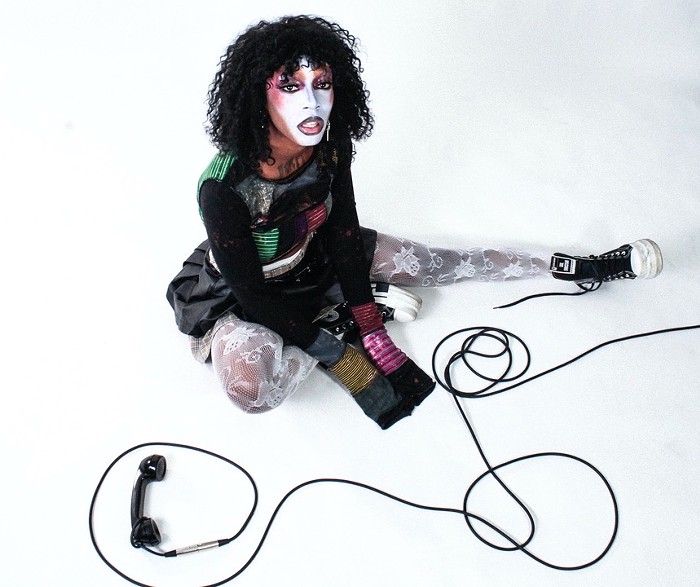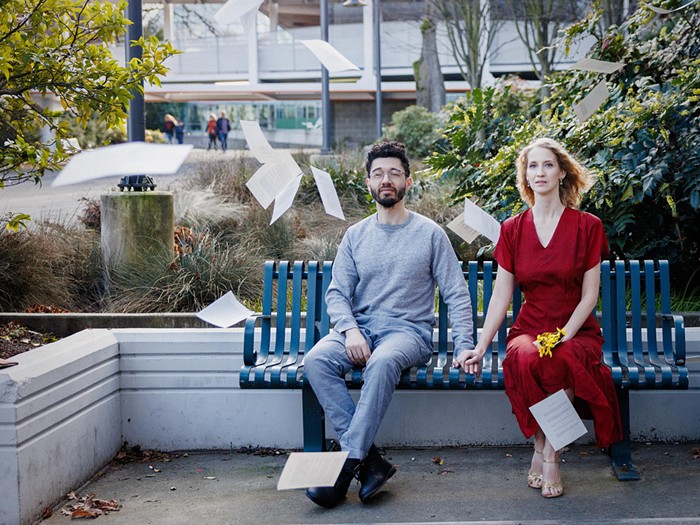What the Hell Is Make Believe Seattle?
Finally, a Film Festival for Fellow Weirdos
The Power of Making People of Color Invisible
Stephanie Syjuco Empowers the Oppressed with Just a Finger
Better, Stronger, Faster
The Seattle Repertory Jazz Orchestra Pays Tribute to the Legendary Oliver Nelson
Where to Pickup a Copy of The Stranger's Spring A+P 2024
Find it at Hundreds of Locations Around Seattle!
Queen of Our World
When Sasha taqwšəblu LaPointe Writes, the Revolution’s Coming
Blowing Minds and Melting Faces
Thunderpussy Celebrate Their Survival with a Surprising Benaroya Hall Takeover
Person of Interest: Arson Nicki
Finally, a Fashion Expert for the People
Six Films You Need to See at Make Believe Seattle
Starring Ethical Vampires, Ridiculous Puppets, and a Dude Who Pretends to Be George Lucas for Funsies
Art, Illness, and Auto Repair
Cherdonna Makes a Compassionate Comeback
Person of Interest: TeZATalks
Harbinger of Horror-Filled Hardcore Pop
It’s Important That the Bug Undulates
How Anida Yoeu Ali Uses Wiggling Worms and Glitter as Forms of Protest
Sincerely Joking
Chastity Belt Live, Laugh, and Love 10 Years On
Your Spring Arts Itinerary
24 of This Season’s Very Best Art, Books, Music, Film, Theater, and Food Events
Tessa Hulls’s Feeding Ghosts Is Instant Canon Fodder
Too Bad She’ll Never Write Another Graphic Novel
Isabel Hagen’s Comedy Strings You Along
How a Juilliard-Trained Violist Found Harmony as a Stand-Up Comedian
Person of Interest: Taha Ebrahimi
Seattle’s Coolest Street Tree Expert
My appreciation for Stephanie Syjuco’s impressive and influential body of work—the latest of which, After/Images, will be on display at Frye Art Museum in June—begins with Alfred Hitchcock’s 1959 thriller North by Northwest.
The key scene in this movie, for me, is when Cary Grant is on the Chicago-bound 20th Century Limited train. What gets me every time we are in the dining cars is not the Hollywood hunk (Cary Grant) or the blonde bombshell (Eva Marie Saint), but the unnamed and silent Black men working the bars and tables. They are on the edges of the scene. But I notice them and not the white-bright stars. I see members of my family in them. Those who worked jobs just like they do. Even the Black hand that serves Grant a cocktail is recognizable. That is a big part of the film for me, and also why I have a deep and lasting appreciation for Syjuco’s work. Her zone of interest is the visible and invisible at the edges of her and my culture, Western culture.
Second, I’m a neo-structuralist. I still very much believe in the theoretical regimes developed in this period (the 1960s), and mostly in France (though continued in the UK by the Black sociologist Stuart Hall). Structuralism’s explanatory power has, even in our time, yet to be exhausted—and, fundamentally, never needed post-structuralism in the way modernism needed post-modernism. I believe in the basics of this movement (semiotics) and its founders and refiners (Ferdinand de Saussure, Roland Barthes, Julia Kristeva). This is why the work of early Barthes (structuralism) can explain Syjuco’s artistic interventions better than the work of Gilles Deleuze or Michel Foucault (post-structuralism). The Manila, Phillippines-born and San Francisco-raised Syjuco recognizes that there is no document in “civilizatinion” that’s not coded. The question for her is, then: What does the code represent? What is its historical context? What structures it? Is it liberating? Or is it oppressive? And if the latter, how can we recode (liberate) the code?
At times, for Syjuco, all it takes is a finger.

In her series Block Out the Sun, Syjuco makes the visible Filipinos in archival black-and-white photographs invisible with her hand. The exploitation, the humiliation (those, for example, performing Filipino village life during the St. Louis World’s Fair in 1904 for white gazers) are made invisible. You can’t see them. You see instead their setting (the “living exhibit’s” fake village) or their superiors (white Americans). This simple intervention unexpectedly makes those we do not see more visible. And here we find the strange power of Syjuco’s invisibility. It’s strange because it’s also the very opposite of the Black visibility in my Hitchcock scene. Here, when I placed the finger in my mind on Cary Grant and Eva Marie Saint, what I saw was the Black life on the edge of the narrative’s core. I saw someone who looks just like my uncle—the one who likes fishing and lots of sugar in his morning tea. That’s him at work. There, behind the bar. But in Block Out the Sun, we enter the other side of my recoding at the edges. Those not seen are empowered. How is this possible?
The key is found in the final essay, “Escaping the Archive’s Gaze,” in Frye’s superb book for the exhibit, After/Images. Aruna D’Souza, the essay’s writer, presents—after explaining the massive amount of time and energy Syjuco committed to the archives in several American institutions, and how this research has been at the center of her recent work, and the installations, footage, modified photographs, photographs of photographs, time-spoiled photographs, texts, and images from Seattle’s Filipino community in Frye’s exhibit—”one of the key ideas in the Martinican poet and post-colonial theorist Édouard Glissant’s Poetics of Relation.” It was “originally published in French in 1990.” The idea is simply this: “the right to opacity.” But the idea’s simplicity (and even obviousness, particularly in the present age of AI) is also sophisticated, as it “stands in opposition to Western ontology’s demand for transparency—a demand to probe the secrets of the Other (whether an individual or a culture) as a precondition for understanding them.”
What is this right to opacity about? D’Souza writes:
The demand for transparency, Glissant points out, has determined every aspect of the West’s colonial enterprises: it motivated the colonial authorities who wanted to count, classify, and catalogue the inhabitants of their newly conquered lands... For a colonial subject to insist on opacity in the face of this demand to bare oneself to the gaze of colonizers and their knowledge gatherers was to assert the right to remain unknown, to reveal oneself only within a relationship of equality and consent—in other words, quite the opposite of the relationships produced by imperial domination.
In a nutshell, it’s the right to be seen and also not seen. The Filipinos in the images Syjuco found in the archives did not have this right. They were forced to be seen. And so, in this sense, visibility was not empowering. It was violently oppressive. And this is the genius of Syjuco’s Block Out the Sun series—a genius found in her other projects, such as the textual “Blind Spot”—she can recode by the direct act of un-coding. The code does not vanish when it’s unseen. It does not become invisible. It is, in the most fundamental sense, recoded.
Stephanie Syjuco: After/Images shows at Frye Art Museum June 1–September 8.




















